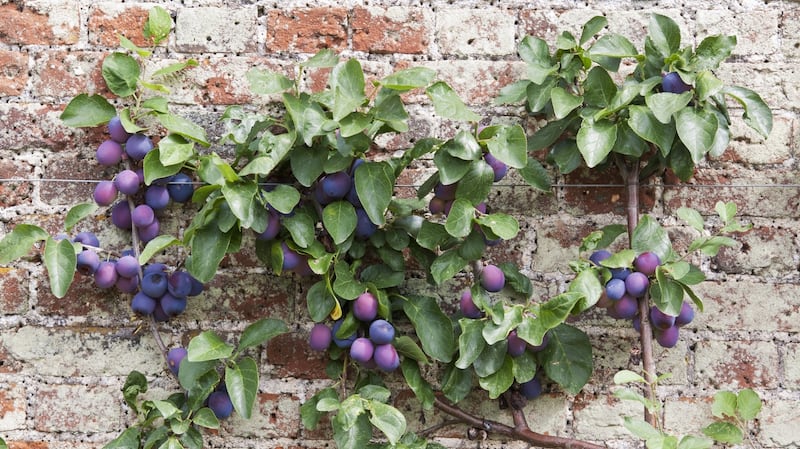Q: I’d like to add a fruit tree (apple, pear or plum) and would love to train one as an espalier against this south-facing fence (pictured). As you can probably see, I am not an expert gardener and I suspect an espalier may be beyond me, so would appreciate any advice, tips or alternatives you may have. CD, Co Kildare
A: An espalier-trained fruit tree, where the branches of the tree are trained to grow in a succession of horizontal tiers against a wall or tall, sturdy fence, is a wonderfully space-efficient, decorative, productive way to grow apples and pears in a suburban garden like yours, where there’s plenty of great vertical growing space available.
An age-old technique, you can see fantastic examples growing in the OPW-managed Ashtown Walled Garden in the Phoenix Park, as well as in RHSI Russborough’s walled Victorian garden near Blessington, Co Wicklow.
For your own garden, you have two options. One is to start the training process from scratch, while the other is to buy a young tree that’s already been partially formatively trained by a specialist nursery.
READ MORE
Starting from scratch is cheaper, but slower and a little more challenging. You’ll need to begin with a very young, single-stemmed tree – or what’s called a ‘maiden’ or a ‘whip’ grafted onto a dwarfing or semi-dwarfing rootstock to keep it relatively compact.
You’ll then have to fastidiously prune and train over a period of several years using bamboo sticks and a series of horizontal training wires fixed to your garden fence to create the basic framework.
The process isn’t so much difficult but it’s slow and finicky, and requires careful timing and a keen eye for detail. I don’t have space to cover it here but you’ll find a clear step-by-step guide on the RHS website (rhs.org.uk).

The alternative is to buy a young tree from a garden centre or specialist supplier that’s already been partially trained. This partially-trained espalier tree will still need to be pruned and trained twice a year in its early years (once in late winter and then again in late summer), a process that can sound off-putting when you’ve never done it before, but is actually very straightforward once you get the hang of it.
For this reason, I’d also highly recommend doing a practical workshop on pruning fruit trees to give you a hands-on feel of what’s required. Festina Lente is running one on Saturday February 25th and again on Sunday February 26th along with a tour of its beautiful Victorian Garden in Bray, Co Wicklow (festinalente.ie), while Irish Seed Savers in Scariff, Co Clare, regularly run workshops on all aspects of fruit-growing, from grafting your very own fruit tree to pruning and training it (irishseedsavers.ie).
Lastly, bear in mind that an espalier is just one of many ways in which fruit trees can be ingeniously trained into decorative, space-efficient shapes, using techniques that have been passed down through the generations.
Others include standards, stepovers, fans and cordons, some of which are also very suitable for growing cherries, plums, gages, damsons, peaches, nectarines and apricots.
For a very accessible guide, get your hands on a copy of Dr Hessayon’s The Fruit Expert.














